| Japanese | English |
The engine sound of the car and other vehicles is merely an annoying noise disturbance for most people. Most of us don't want to hear such sound in our daily lives. But you may notice that the sound of some car is very loud but others are not. Interestingly, some enthusiasts, or automanias, expresses the exhaust noise of car engines as "notes". It means that they are recognizing engine noise as a kind of music and enjoying its pleasant melody. It is obvious that the sound pressure level (SPL) is not the only factor for determining its loudness, annoyance, and pleasantness of sound. Other sound attributes, such as pitch and timbre, change the impression of engine noise greatly.
Each car has its own exhaust note, and its sound changes as cars are modified by replacing some parts and accessories. So, it may be possible to identify a particular car and its components by hearing the sound. Also, the exhaust notes is very important for maintenance and tuning of the race car, because the sound directly reflects the condition and the performance of engines. Some people can diagnose the performance of engines only by hearing its operation sound. Their brain may grasp key features of sound and perform such difficult discrimination tasks. I believe that the similar task can be achieved by analyzing sound's characteristics.
At the beginning, the exhaust sound of Ferrari Mondial t is measured during idling. The purpose of the first measurement is to analyze the rotational speed of the engine from its sound.


Microphone was placed at the back of the car to record the engine sound clearly. Microphone was connected to the PC's soundcard via the amplifier. Incoming sound was recorded in the sound recorder of the Realtime Analyzer directly (see this page for how to record sound). DAT recorder or digital video camera can also be used for sound recording. The sound can be transferred to the PC and analyzed later.
![]() ferrari1.wav (44.1kHz / Stereo / 15sec / 2.52MB)
ferrari1.wav (44.1kHz / Stereo / 15sec / 2.52MB)
Right-click the above link to download the sound file. Realtime analyzer has a function to load and analyze the wav files.

Start the Realtime Analyzer and open the Recorder, and click the "Load" button to read the wav file.
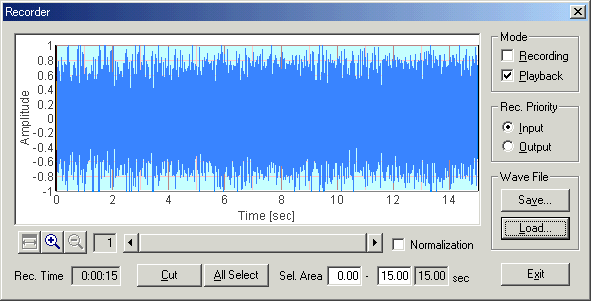
Then, open the FFT analyzer and start the measurement. Loaded wav file is played and the measurement starts automatically. Below is the measured power spectrum. Only one channel is measured here. The spectrum is almost constant during the measurement, but is varying slightly because the sound is not stationary. So, the smoothing is applied for 1 second to make a clear graph. If you want to see the time varying spectrum, spectrogram view is also convenient.
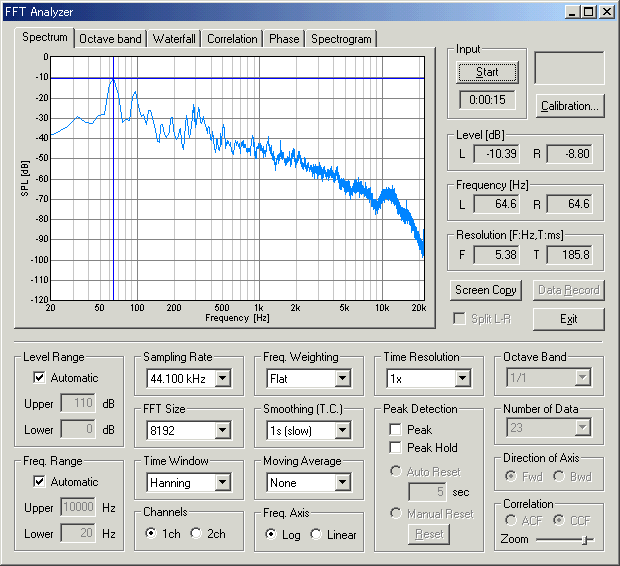
You can see several peaks in the spectrum. The highest peak is indicated by the crossing, its frequency (64.6 Hz) is displayed in the right of the graph. This is the fundamental frequency of this sound. Generally, the engine sound consists of the fundamental frequency and its harmonics (i.e. x2, x3, x4, etc. of the fundamental). The structure and the relative amplitude of these harmonics determine most of the tonal quality (timbre) of sound. In addition, you can see a prominent peak around 300 Hz. This is called the formant frequency. Formant is also called a resonance frequency. At this frequency, the exhaust pipe resonates the most and the sound energy becomes the maximum. There is also anti-resonance frequency. It is the frequency component that weakens the sound energy extremely. The combination of such frequency components is making the sound waveform.
The fundamental frequency at 64.6 Hz means there are 64.6 firings in 1 second. This means 3876 firings in 1 minute. Because this engine is a 4-stroke 8-cylinders engine, 3876 firings in 1 minute corresponds 969rpm (3876 / 4). For a rapid calculation, rpm can be obtained by "multiplying the fundamental frequency by 15."
In the four stroke engine, each cylinder is fired once for every two revolutions of the crankshaft. That is, the fundamental frequency of the engine vibration is half of the number of engine rotations.
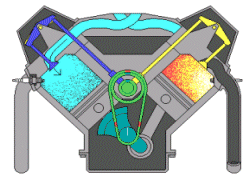
In case of a 8-cylinder engine, if the firing occurs at equal intervals without overlapping, the number of the firing is 8 times. So there will be four firing pulses per engine rotation. Similarly, a 6-cylinder engine will have three, a 4-cylinder engine will have two pulses per rotations. From these relationships, the fundamental frequency of the engine sound is: rotation speed / 2 * number of cylinders. The more cylinders there are, the more its sound will have high fundamental frequency. The lowest frequency by the explosion should be the fundamental frequency.
The octave analyzer measures the sound energy in every frequency band. After calibrating the input sensitivity of the microphone, it can be used as the sound level meter.
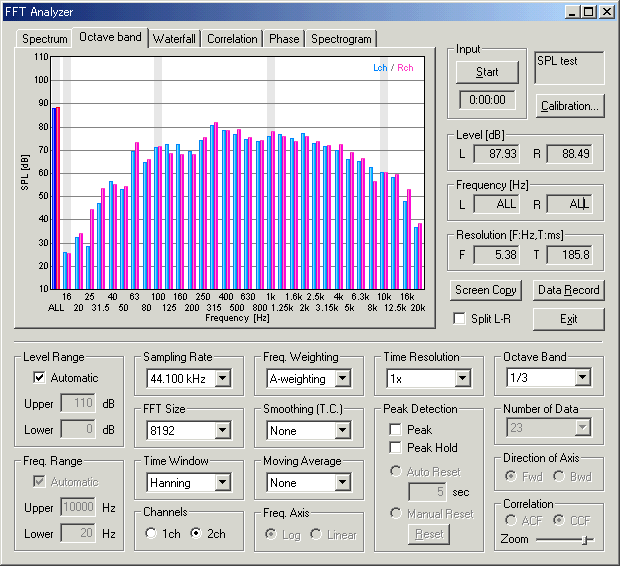
The real time display of the autocorrelation function. We can see a periodic structure. The fundamental period is about 3 ms, corresponding to the peak frequency at 300 Hz in the power spectrum.
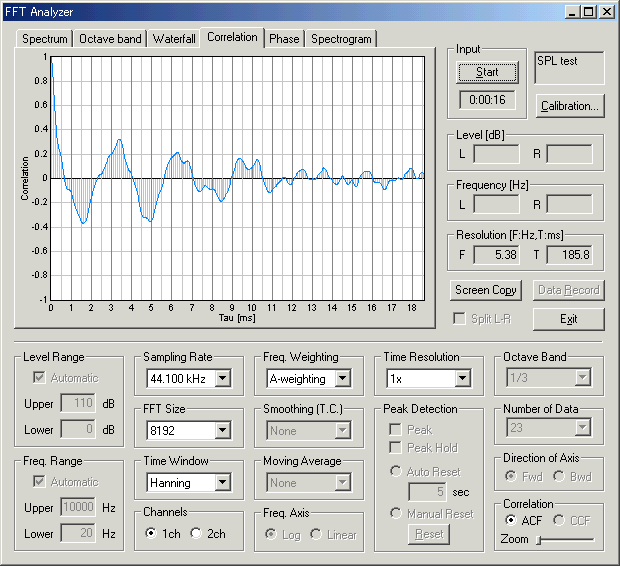
This time, the exhaust sound of car engine was analyzed to estimate the rotation speed. Measurement report of the exhaust sound continues...
April 2003 by Masatsugu Sakurai